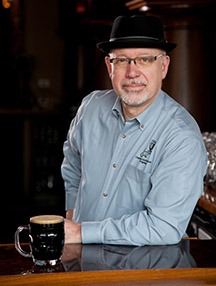Beer Evaluation: Tips from the Pros
Tasting critically isn’t only for judges. In fact, it greatly benefits all brewers. Being able to evaluate changes to recipes, techniques, and fermentation dynamics is the best way to determine what works and doesn’t work. Two experts in this field share their advice for homebrewers who want to better their evaluation skills.
Gordon Strong, President of the Beer Judge Certification Program

I like to use what I call “structured tasting,” or learning how to break apart the different characteristics of a beer so that you can communicate your perceptions. The major steps of this are: 1) identifying your perceptions, 2) quantifying and qualifying those perceptions, and 3) differentiating those perceptions. This isn’t even talking about what you think about a beer, but first what you sense (perceive) in it. Put a name on each perception, then describe how strong it is, and then see if you can refine it by applying more detail (lemony is more refined than citrusy, which is more refined than fruity, for instance). Practice this process by tasting commercial beer or homebrew by yourself or in groups. This gets you in the habit of thinking critically about beer, not just drinking and enjoying it.
After that, learning more about common faults in beer is important, as well as learning how to compare a beer against written standards, like a style guideline. Tasting with others, especially trained judges, helps your sensory identification skills and your calibration of perceptions and assessments.
Learning how to assess appearance and mouthfeel are easier, but less important, than flavor and aroma. When you have more advanced skills, I like to tell people to think about what is important for the style to have, and what sets it apart from similar styles — then ask whether the beer you are evaluating actually delivers on those points. If it doesn’t, can you identify what is wrong, and how serious it is relative to the positive points you notice? That is the beginning of evaluating and judging beer.
Practicing these skills alone allows you to do it at any time. You are free of bias and suggestion. However, you don’t necessarily know that you are right. Working in a group can help you learn the language and to identify faults you haven’t tasted before. It also can help with calibrating your senses. However, if the group is inexperienced or poorly led, it can reinforce bad habits. So if working in a group, it should have an experienced judge as the lead, but people should record their own perceptions individually before discussing them as a group.
The best way to learn? Lots of beer. Seriously, try various styles and examples, commercial and homebrew, everything. Fault kits can teach you how to put a name on a chemical, but you can develop these skills through judging. I’d rather see people use the Beer Judge Certification Program Style Guidelines and a score sheet than pick up a beer and start working through the process. Using a fault kit is best if it’s part of a group training exercise, and this is sometimes an advantage of taking an exam prep class. That said, I prefer to obtain naturally occurring faults in beers through homebrew competitions, or to take my homebrew to a homebrew club meeting where you can discuss faults with other brewers. Artificial faults don’t appear like natural faults in actual beer; they often lack other clues that impact your ability to recognize the problem. The fault kits help you learn how to identify a chemical, only.
I strongly believe that becoming a beer judge will make you a better brewer, and becoming a good brewer will make you a better beer judge. So
I think you should be both. You can recognize and troubleshoot your own beer without having to wait for competitions, so you can make improvements much faster. Even if you don’t want to become a beer judge, you will still use these skills; you just communicate your findings with yourself rather than another brewer.
Ray Daniels, Founder of the Cicerone Program

When I started homebrewing, I thought I could brew great beer just by following a recipe and proper procedures. Well it just isn’t true! Brewers need good tasting skills to make great beer. To be an accomplished brewer, you have to understand 1) what flavors are in your beer and 2) how they are created.
Tasting skill is something that you can develop and refine throughout your life. It won’t come overnight. But you can develop a good set of basic skills in a short while. And, if you enjoy the process, then you can enjoy tasting and expanding your knowledge and skills for a very long time.
Personally, I faced two big challenges trying to develop tasting skills as a homebrewer. First was “cellar blindness.” This is what happens when you taste a beer you know (like your own homebrew). If you start out knowing the style and brand — or even the ingredients and process in the case of your own homebrew — you tend to taste the things that you expect. As a result, you miss flaws and fail to develop your ability to actually recognize flavors without advance knowledge about the beer.
As a second challenge to developing tasting ability, homebrewers can have trouble finding authoritative guides to learn from. Accomplished tasters are not always the people with the most confidence or years of experience. And when you hear different things about one beer from different “experts” it gets confusing. Finding a true authority to taste with makes a huge difference in your development as a taster. Another tool in this area is tasting of vetted and spiked samples on a blind basis. Here the flavor profile of the beer is well established, and by tasting it blind, you get the chance to actually develop your detection and assessment skills rather than just looking for what is supposed to be there.
In the Cicerone program, we have learners blind taste beers that have been selected (or prepared) and then vetted by skilled tasters to demonstrate specific traits. Using this method, we introduce tasters to an initial range of flavors so that they can build a basic tasting vocabulary. In addition, we teach the six most common off-flavors encountered in beer, using spiked samples. By starting with a focused set of attributes and using repeated exposure in blind tastings, tasters become confident in identifying (and describing) the fundamental flavors of beer. Once you are confident with the basics, you are in a position to learn more flavors with more confidence and speed. Within Cicerone, we also offer more advanced spiked sample training, which can be done on your own to introduce and foster skills related to broader ranges of off-flavors.


